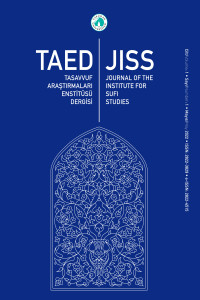Commentary of the Saying “He who knows himself, knows his Lord.” from the Angles of Sufism and Anatomy
Öz
The saying of “Man ʻarafa nafsah, fa-ḳad ʻarafa rabbah: He who knows himself, knows his Lord.” contains indications both to the body and the soul, since the human being’s self is formed as al-ḳālib/djism (body), and al-rūḥ (soul). This sentence is known from the ancient times in different styles. It is also referred frequently in Sufism, and even known as a Ḥadīth. This saying is important from the aspect of purification of the lower soul as well as from the aspect of the Science of Anatomy and unity of being. We can even say that in order to understand this saying, these three aspects should be considered together in a consequent form, and that is: Human being’s search for finding his Lord is bound to his practices of purification of his soul from bodily and worldly desires in a sufficient degree. When this is done, he will begin to see God even in his wordly body, since his body consists of extra-ordinary particulars, forms, organs and and their functions. After gaining this sight, he will also comprehend that his Lord is far from being known in His essence, since His essence is above all definitions and above limitations of human being’s intellect. He can only be known partly through his names and attributes.
Anahtar Kelimeler
Sufism and Medicine Lower Soul Purification of the Lower Soul Anatomy Unity of Being. Sufism and Medicine, Lower Soul, Purification of the Lower Soul, Anatomy, Unity of Being.
Kaynakça
- Erzurumlu İbrahim Hakkı. Mârifetnâme. Sade. T. Ulusoy. İstanbul: İHHCKYYD (İbrahim Hakkı Hazretlerinin Câmii ve Külliyesini Yaptırma ve Yaşatma Derneği), 1974.
Commentary of the Saying “He who knows himself, knows his Lord.” from the Angles of Sufism and Anatomy
Öz
The saying of “Man ʻarafa nafsah, fa-ḳad ʻarafa rabbah: He who knows himself, knows his Lord.” contains indications both to the body and the soul, since the human being’s self is formed as al-ḳālib/djism (body), and al-rūḥ (soul). This sentence is known from the ancient times in different styles. It is also referred frequently in Sufism, and even known as a Ḥadīth. This saying is important from the aspect of purification of the lower soul as well as from the aspect of the Science of Anatomy and unity of being. We can even say that in order to understand this saying, these three aspects should be considered together in a consequent form, and that is: Human being’s search for finding his Lord is bound to his practices of purification of his soul from bodily and worldly desires in a sufficient degree. When this is done, he will begin to see God even in his wordly body, since his body consists of extra-ordinary particulars, forms, organs and and their functions. After gaining this sight, he will also comprehend that his Lord is far from being known in His essence, since His essence is above all definitions and above limitations of human being’s intellect. He can only be known partly through his names and attributes.
Anahtar Kelimeler
Sufism and Medicine Lower Soul Purification of the Lower Soul Anatomy Unity of Being. Sufism and Medicine, Lower Soul, Purification of the Lower Soul, Anatomy, Unity of Being.
Kaynakça
- Erzurumlu İbrahim Hakkı. Mârifetnâme. Sade. T. Ulusoy. İstanbul: İHHCKYYD (İbrahim Hakkı Hazretlerinin Câmii ve Külliyesini Yaptırma ve Yaşatma Derneği), 1974.
Ayrıntılar
| Birincil Dil | İngilizce |
|---|---|
| Konular | Din, Toplum ve Kültür Araştırmaları |
| Bölüm | Araştırma Makaleleri |
| Yazarlar | |
| Yayımlanma Tarihi | 3 Ağustos 2022 |
| Yayımlandığı Sayı | Yıl 2022 Cilt: 1 Sayı: 1 |

